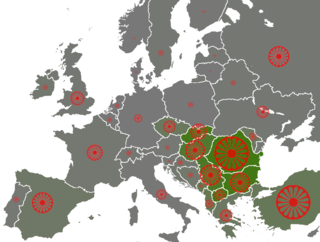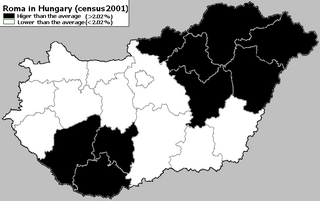
The Romani, also spelled Romany or Rromani and colloquially known as the Roma, are an ethnic group of Indo-Aryan origin who traditionally lived a nomadic, itinerant lifestyle. Linguistic and genetic evidence suggests that the Romani originated in the Indian subcontinent, in particular the region of present-day Rajasthan. Their subsequent westward migration, possibly in waves, is now believed by historians to have occurred around 1000 CE. Their original name is from the Sanskrit word डोम, doma and means a member of the Dom caste of travelling musicians and dancers. The Roma population moved west into the Persian Ghaznavid Empire and later into the Byzantine Empire. The Roma are thought to have arrived in Europe around the 13th to 14th century. Although they are widely dispersed, their most concentrated populations are located in Bulgaria, Hungary, Romania, Spain, and Turkey.

Compulsory sterilization, also known as forced or coerced sterilization, is a government-mandated program to involuntarily sterilize a specific group of people. Sterilization removes a person's capacity to reproduce, and is usually done through surgical procedures. Several countries implemented sterilization programs in the early 20th century. Although such programs have been made illegal in most countries of the world, instances of forced or coerced sterilizations persist.
The European Roma Rights Centre (ERRC) is a Roma-led, international public interest law organisation engaging in a range of activities aimed at combating anti-Romani racism and human rights abuse of Romani people. The approach of the ERRC involves, in particular, strategic litigation, international advocacy, research and policy development, human rights focused news production, and the training of Romani activists.
The Romani people, also referred to as Roma, Sinti, or Kale, depending on the subgroup, are an Indo-Aryan ethnic group that primarily lives in Europe. The Romani may have migrated from what is the modern Indian state of Rajasthan, migrating to the northwest around 250 BC. Their subsequent westward migration, possibly in waves, is now believed to have occurred beginning in about 500 AD. It has also been suggested that emigration from India may have taken place in the context of the raids by Mahmud of Ghazni. As these soldiers were defeated, they were moved west with their families into the Byzantine Empire.

Romani people in Bulgaria constitute Europe's densest Roma minority. The Romani people in Bulgaria may speak Bulgarian, Turkish or Romani, depending on the region.

Anti-Romani sentiment is a form of bigotry which consists of hostility, prejudice, discrimination, racism and xenophobia which is specifically directed at Romani people. Non-Romani itinerant groups in Europe such as the Yenish, Irish and Highland Travellers are frequently given the name "gypsy" and as a result, they are frequently confused with the Romani people. As a result, sentiments which were originally directed at the Romani people are also directed at other traveler groups and they are frequently referred to as "antigypsy" sentiments.

Romani people are an ethnic minority in the Czech Republic, currently making up 2–3% of the population. Originally migrants from North Western India sometime between the 6th and 11th centuries, they have long had a presence in the region. Since the creation of Czechoslovakia in 1918, the Romani population have experienced considerable hardship, having been a main target of Nazi extermination programs during World War II, and the subject of forced relocation, sterilisation, and other radical social policies during the Communist era. In the successor state, the Czech Republic, challenges remain for the Romani population with respect to education and poverty, and there are frequent tensions with the white majority population over issues including crime and integration.
Barbora Bukovská is a Czech-Slovak human rights attorney and activist, known originally for her work on racial discrimination of Romani people in the Czech Republic and Slovakia, and later for free speech advocacy.

The Romani people have several distinct populations, the largest being the Roma and the Calé, who reached Anatolia and the Balkans in the early 12th century, from a migration out of the Indian subcontinent beginning about 1st century – 2nd century AD. They settled in the areas of present-day Turkey, Greece, Serbia, Romania, Croatia, Moldova, Bulgaria, North Macedonia, Hungary, Albania, Kosovo, Bosnia and Herzegovina, Czech Republic, Slovenia and Slovakia, by order of volume, and Spain. From the Balkans, they migrated throughout Europe and, in the nineteenth and later centuries, to the Americas. The Roma population in the United States is estimated at more than one million.
The presence of a Romani minority in Ukraine was first documented in the early 15th century. The Romani maintained their social organizations and folkways, shunning non-Romani contacts, education and values, often as a reaction to anti-Romani attitudes and persecution. They adopted the language and faith of the dominant society, being Orthodox in most of Ukraine, Catholic in Western Ukraine and Zakarpattia Oblast, and Muslim in Crimea.

Romani people in Hungary are Hungarian citizens of Romani descent. According to the 2011 census, they comprise 3.18% of the total population, which alone makes them the largest minority in the country, although various estimations have put the number of Romani people as high as 8.8% of the total population. They are sometimes referred as Hungarian Gypsies, but that is sometimes considered to be a racial slur.
The number of Romani people in Ireland is roughly estimated, as the Central Statistics Office collects its data based on nationality and not ethnic origin. For this reason a precise demographic profile of the Romani in Ireland is not available. Some estimates of Romani in Ireland give the population at 1,700 in 2004, rising to between 2,500 and 3,000 in 2005. The majority derived from Romani populations originating in Ukraine and Hungary.
The Romani people in Turkey or Turks of Romani background are Turkish citizens and the biggest subgroup of the Turkish Roma. They are Sunni Muslims mostly of Sufi orientation, who speak Turkish as their first language, in their own accent, and have adopted Turkish culture. Many have denied their Romani background over the centuries in order to establish a Turkish identity, to become more accepted by the host population. They identify themselves as Turks of Oghuz ancestry. More specifically, some have claimed to be members of the Yörüks, Amuca, Gajal or Tahtacı.
Romani people in France, generally known in spoken French as gitans, tsiganes or manouches, are an ethnic group that originated in Northern India. The exact number of Romani people in France is unknown; estimates vary from 500,000 to 1,200,000.

There have been Romani people in Croatia for more than 600 years and they are concentrated mostly in the northern regions of the country.
K.H. and Others vs. Slovakia is the first in a series of cases before the European Court for Human Rights dealing with the subject of forced sterilisation of Romani people or Gypsy women from Slovakia. The case did not deal with sterilization directly but it concerned access to medical records of forcibly sterilized Romani women for the purpose of litigation of their rights.
After World War I, the Romani people in Czechoslovakia formed an ethnic community, living on the social periphery of the mainstream Czechoslovakian population.

The Romani are an ethnic group that has lived in Austria since the Middle Ages. According to the 2001 census, there were 6,273 Romani speakers in Austria, or less than 0.1% of the population. Estimations count between 10,000 and 25,000. A more recent estimation count between 40,000 and 50,000 Romani people or about 0.5%. Most indigenous Romani people in Austria belong to the Burgenland-Roma group in East-Austria. The majority live in the state of Burgenland, in the city of Oberwart and in villages next to the District of Oberwart. The Burgenland-Roma speak the Vlax Romani language.

Romani people in Germany are estimated to around 170,000-300,000, constituting around 0.2-0.4% of the population. One-third of Germany Romani belong to the Sinti group. Most speak German or Sinte Romani.
Albania houses a large population of Romani, who are part of the larger Romani diaspora.












